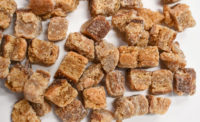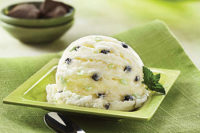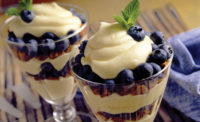Texturally speaking, “ice cream” is something of a misnomer. Yes, consumers expect the frozen treat to be creamy; but any hint of actual iciness — either in the scoop or on the palate — qualifies as an unmistakable quality flaw.
There’s always a backlash to the backlash.
So if “clean” labeling and the relentless drive toward good-for-you formulation represented a backlash against nutritional excesses of the past, it should come as no surprise that the pendulum is swinging again, and consumers are rediscovering their appetites for decadence.
For proof, one need look no further than Black Tap Craft Burgers & Beer, a New York City eatery that became a social media sensation by crowning its milkshakes with everything from cotton candy and cookies to full-sized slices of cake and pie.
“They’re as much a visual treat as a real one,” said Keerthana Perumbala, a marketing associate for sweet and beverage flavors at Sensient Flavors, Hoffman Estates, Ill., and an admirer of the creamy confections.
And while it’s questionable whether anyone actually consumes these shakes in their entirety — rather than just posting photos of them to Instagram — their very notoriety underscores a fundamental reason we love inclusions: They make being “bad” taste really good.
Pendulum swinging
“It seems that in the food world, the pendulum is always on the verge of its next swing,” observed Thomas Payne, industry specialist, U. S. Highbush Blueberry Council, San Mateo, Calif. “Obviously, indulgence is in the eye of the beholder. But there comes a time when we feel entitled to indulge — when we tell ourselves we’ve paid enough dues and deserve a little judicious rule breaking amidst all those clean labels out there.”
Enter inclusions.
“Perhaps there’s something in human nature that equates inclusions with fun,” Payne said, “like when we first realize that ice cream doesn’t just have to be vanilla. Inclusions have a value-added appeal that tells us we’re getting more than we bargained for.”
That makes sense to John Pimpo, sales manager – east for Gertrude Hawk Ingredients, a division of Barry Callebaut USA LLC, Dunmore, Pa.
“We think consumers strive — and want — to eat healthy most of the time,” he noted. “But they do want to treat themselves occasionally. And when they do, they want the good stuff.”
Indulgence train
This is nothing new, as Pimpo traces what he calls the “inclusion indulgence train” back to the early 1980s, when cookies and cream ice cream first started appearing alongside the chocolate chip and marble fudge varieties. After that, it was only a matter of time before cookie dough, brownie bites, Moose Tracks and more greased the skids of a trend that, according to Pimpo, “just keeps rolling.”
Jamie Wilson, director, business development, marketing, culinary, research and development for Parker Products, Fort Worth, Texas, has also witnessed the inclusion train chugging on, noting that, “over time, consumers have become more adventurous, seeking specialty and fine inclusions.”
Her exhibit A is the aforementioned “freak shake trend” that’s turned doughnuts, brownies and cupcakes into mix-ins, rather than treats in their own right. And while such shakes are more dare than dessert, they offer “a creative model for elevating dairy products and adding interesting texture, visually stunning appeal and delightful flavor,” she said.
Cribbing from the dessert menu
As to where inspiration for such inclusions comes from, it’s obvious: other desserts.
“Decadent desserts and sweets inspire inclusions such as milk shake, banana split and chocolate truffle,” said Gretchen Hadden, marketing communications manager for Cargill Cocoa & Chocolate, Wayzata, Minn. “So do nostalgic flavors like pumpkin pie, s’mores and hot cocoa.”
Pimpo likens his innovation M.O. to putting everyday desserts into a pint.
“As ice cream developers, I think we all mentally deconstruct a dessert we might have ordered in a restaurant or made at home and ask, ‘How can I make that into an ice cream?’ At least that’s what I do.”
He’s seen continued demand for his company’s boozy brown-butter bourbon truffle inclusions, which coat real Kentucky bourbon and brown-butter caramel in a chocolatey enrobing.
“And with the ‘unicorn’ phenomenon, we’ve been using edible glitter in our new glitter cake-batter stars,” Pimpo went on. “We’re making a sour panned crunchy sugar, and we’ve been panning popping candy in sour coatings and regular fruity coatings. We keep deconstructing recipes for new frozen dessert concepts like our new Belgian waffle ice cream, featuring waffle batter ice cream with maple panned cone pieces.”
But what really moves the inclusion train forward, Pimpo believes, is when product developers not only capitalize on the classics, but also make them better.
“Like adding a chocolate panned coating to the outside of the cookie to keep it crunchy,” he said. “Or using whole mini peanut butter cups or chopped ones that look like you made them yourself. That opens the door for ‘artisan’ ice cream shops or craft pint makers to stretch the bounds of imagination on the next inclusion.”
What’s cookin’?
Wilson finds inclusion inspiration in the Thai rolled ice cream trend.
“A thin base of flavored milk is poured on a cold disk,” she explained, “and as it freezes, paddles are used to craft creamy cylinders, and ingredients such as buttery praline pecans, gooey marshmallows and chocolate sprinkles are mixed in for texture and taste.”
Bringing things back to these shores, her company makes classic baked and precut brownie, cake, piecrust and cookie inclusions to “dress up,” say, a cake batter milkshake, while their hot chocolate variegate and chocolatey brownie bits can “liven up offerings such as marshmallow ice cream.”
For their part, the inclusion inventors at Denali Ingredients, New Berlin, Wis., answer continuing demand for cookie dough inclusions — Nielsen AOC data for the 52 weeks ending April 21, 2018, show that sales of ice creams featuring cookie dough inclusions grew by 14% in the past year — with novel twists such as oatmeal, sugar and “monster” options, said Jon Vander Woude, the company’s vice president of marketing.
“We’ve also added new dough shapes — stars, triangles, ovals, et cetera — and new colors,” he said.
Beyond doughs, the Denali team formulates flakes to function specifically in frozen desserts, and with more flavor and color options to boot, including espresso, lemonade and cola. To bring texture to the flake experience, the company also launched inclusion barks in profiles such as pretzel, peanut and graham.
“Swirling these into ice cream provides an over-the-top indulgent experience,” said Vander Woude.
How sweet it isn’t
Yet Wilson warns developers against relegating inclusions indulgence to sweet dairy alone.
“Cheeses and yogurts can also benefit from inclusions,” she insisted. “Dive into a rich goat cheese rolled in honey-thyme-glazed almonds for appealing flavor and texture. Or pair velvety peach yogurt with spicy sriracha granola for a bold flavor kick.”
Jeff Smith, director of marketing for Blue Diamond Almonds’ Global Ingredients Division, Sacramento, Calif., seconded that motion.
“Yogurt was once strictly a health food, but has recently been made more indulgent with the addition of sweet and savory mix-ins such as almonds, granola or fruit,” he said. “Consumers love the contrast of crispy, crunchy textures with creamy yogurt.”
He’s also seen almond and strawberry mix-ins offered with cottage cheese.
“This is a new take on the dairy mix-in phenomenon that syncs with consumer preferences for sweet and savory pairings, and also adds texture and mouthfeel,” he said.
Feast for the senses
That new take is no small matter for inclusions.
“Consumers love contrasting textures in ice cream and frozen yogurt,” Smith pointed out. “Pairing almonds with softer, chewier inclusions such as brownie bites or fudge bites is just one great way to create that wow factor.”
When it comes to innovation, Vander Woude noted that Denali emphasizes the many senses — such as taste, texture and eye appeal — involved in enjoying dairy to the fullest.
“When all these converge, the experience becomes crazy good and indulgent,” he said.
Thus, mashups of multiple sensations are winding up in a single carton.
“Walk the ice cream aisle and you’ll see products with two or three side-by-side flavors, cores and layers,” Vander Woude said. “Introducing several inclusions takes things one step further.”
For example, his team’s combined two doughs — cookie and brownie — to deliver a “brookie” experience, as he calls it.
“A customer may want a combination of colors and shapes or even different inclusions such as a flake with a dough piece,” he added. “We’re even venturing into indulgent baked inclusions, and we’re excited to discover where this’ll lead, as well.”
But don’t get carried away.
“It’s important to select sensory combinations that complement one another rather than distract and compete,” Wilson cautioned. “Choosing the perfect baked, candy or nut inclusion to complete an ice cream requires thorough evaluation.
“For instance, if a dessert is to embody a homemade feel, we may pair a pecan ice cream with silky caramel, crunchy pecans and buttery piecrust pieces for a take on traditional pecan pie,” Wilson added. “But to convey something artisanal, we may combine a French vanilla base with a note of rose water and swirl with raspberry variegate and sugar cookies for a subtly floral and sophisticated flavor.”
Getting technical
None of this, mind you, is easy from a technical or operational standpoint, either. Packing so much excitement into one container “requires a lot of R&D time to create, test and refine formulations to deliver on all metrics,” Vander Woude said. Unfamiliar ingredients can interact unexpectedly, he noted, and developers must monitor their behavior, adjust ingredients and test early and often to achieve the desired results.
“We recommend careful evaluation and thorough testing to ensure that the combinations complement each other from a flavor perspective,” Wilson added. “Additionally, sizing and moisture should be considered. For instance, many of our inclusions can be customized whether a customer requires adjusted sizing due to unique packaging or a coated product to prevent moisture migration.”
And Smith offers a tip for working with almonds.
“Enrobe them in a hard fat such as chocolate,” he said. “This forms a moisture barrier between the ice cream and the almond, resulting in an extra-crunchy almond texture.”
Yet hard fats such as chocolate can be troublesome inclusions, themselves, particularly vis-a-vis melting points.
“Attaining lower melt points is our biggest challenge in frozen dairy, since consumers don’t want to chip their teeth” on an inclusion that’s rock-solid straight from the freezer, said Thom King, president and CEO of Icon Foods, Portland, Ore.
To avoid such dental dilemmas, his company adds more cocoa butter and “more flexible hydrocolloids” to its chocolatey inclusions to keep them appropriately gooey at eating temperatures.
On the other hand, lowering a chocolate inclusion’s melt point too much can make for messy handling.
“A general rule of thumb for our inclusions is to take onto the floor only what you think you can use in a reasonable amount of time,” Pimpo said. “Our product is low-melt and engineered for ice cream in that it melts at 60° Fahrenheit — making it a perfect ice cream inclusion. But it needs to be kept frozen and used in manufacturing as soon as possible.”
Keep it clean
And what about all those demands for “clean” ingredients, “free-from” labels and the sort of good-for-you profile that keep brands like Halo Top sitting pretty? As far as the experts are concerned, they can coexist with inclusion excess — if you play your cards right.
“I think you can still have indulgence while keeping labels clean,” King said.
The trick lies in how you define “indulgence,” he added. If it simply denotes something that excites consumers’ senses, he believes it can be done while reducing things such as added sugars and still keeping a clean label.
King’s company is proving that theory with its sugar-free clean-label chocolate chip inclusions.
“These are created using a combination of sweeteners, fibers and hydrocolloids to deliver mouthfeel, flavor and rapture,” he said.
The team is deploying the same strategy to develop sprinkles in flavors such as snickerdoodle and birthday cake, while also working on marshmallow bits in “fun shapes and colors” and looking to nuts “for crunchiness.” And in every case, King said, the inclusions are clean-label and have zero sugar.
Smith noted that almonds fit in well within the trend toward simpler labels and great-tasting, healthful ingredients.
“That’s why we’re seeing more innovation around using almonds as indulgent dairy inclusions that deliver great taste and texture in bite-sized pieces,” he said.
Payne added that blueberries are full of surprises as dairy inclusions.
“Delectably good and also definitely good for you, they’re the go-to ingredient for unapologetic indulgence,” he said.
Payne suggested working with a variety of formats to create indulgent effects.
“For example, blueberry stir-ins and inclusions in the form of dried or crushed blueberries add blueberry goodness to just about anything,” he said. “They impart a mild fruit flavor compatible with frozen yogurts. With their natural high sugar levels, they also help to counter the sour taste sometimes associated with yogurt, naturally sweetening the product.”
Which will count as a plus even among consumers who’ve embraced indulgence.
“Despite the pendulum swinging back toward health-conscious and clean labeling, there will forever be a place for unapologetic indulgence in categories like frozen dairy,” Hadden said. “While some consumers bring their label-conscious ways into the ice cream aisle, others look at ice cream as a treat without any restrictions or parameters. So there is a place for both better-for-you and indulgence in the ice cream aisle.”






